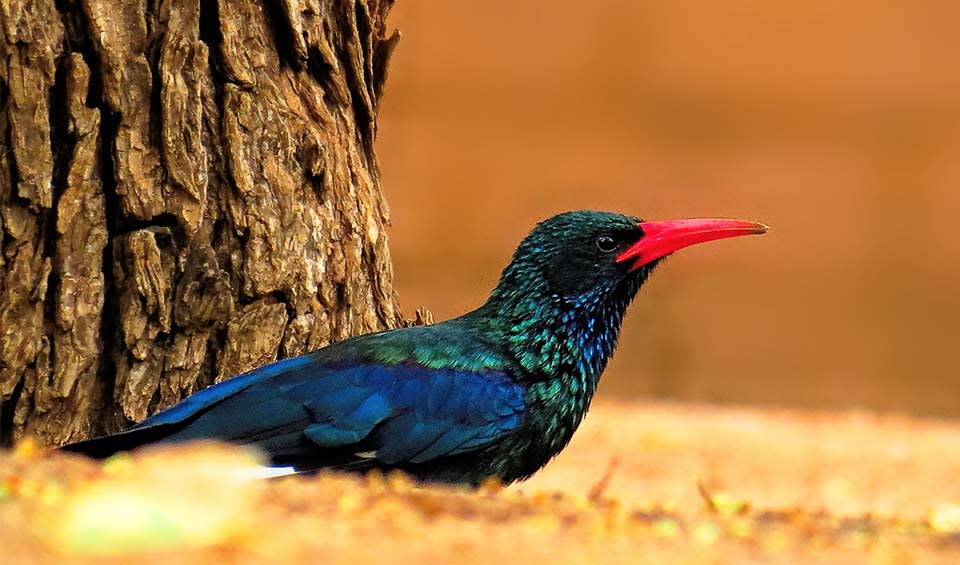Formerly known as the Red-billed Wood Hoopoe, it is a striking example of the diverse and colorful avian life in sub-Saharan Africa’s woodlands. This species embodies the exotic allure of African birdlife with its vivid green plumage, curved red bill, and distinctive purple tail with a diamond-shaped pattern. While its appearance may seem almost too fantastical to be real, the Green Wood Hoopoe is indeed a native of this continent, where it graces the trees with its presence.
One of the most intriguing aspects of the Green Wood Hoopoe’s lifestyle is its social behavior. These birds are highly gregarious, typically forming tight-knit groups consisting of several individuals, or even dozens, as they move through the forest canopy in search of food and suitable nesting sites. Despite their arboreal lifestyle, Green Wood Hoopoes are not exclusively tree-dwellers; they are known to descend to the ground to forage for prey, which primarily consists of insects and lizards. Their special claws are well-adapted for grasping onto branches, allowing them to easily navigate the dense foliage.
Within these social groups, a fascinating dynamic unfolds. Unlike many other bird species where hierarchical structures prevail, Green Wood Hoopoe packs are not governed by a single dominant individual. Instead, the dominant pair within the group assumes leadership roles, guiding the collective decisions and movements of the entire flock. This unique social structure sets them apart from many other bird species and speaks to the cooperative and egalitarian nature of their societies—truly a testament to their remarkable intelligence and adaptability.
Distribution
 Angola
Angola Benin
Benin Botswana
Botswana Burkina Faso
Burkina Faso Burundi
Burundi Cameroon
Cameroon Central Af. Rep.
Central Af. Rep. Chad
Chad Côte D’ivoire
Côte D’ivoire DR Congo (Kinshasa)
DR Congo (Kinshasa) Eritrea
Eritrea Eswatini
Eswatini Ethiopia
Ethiopia Gambia
Gambia Ghana
Ghana Guinea-Bissau
Guinea-Bissau Guinea
Guinea Kenya
Kenya Lesotho
Lesotho Malawi
Malawi Mali
Mali Mauritania
Mauritania Mozambique
Mozambique Namibia
Namibia Niger
Niger Nigeria
Nigeria Rwanda
Rwanda Senegal
Senegal Sierra Leone
Sierra Leone Somalia
Somalia South Africa
South Africa South Sudan
South Sudan Sudan
Sudan Tanzania
Tanzania Togo
Togo Uganda
Uganda Zambia
Zambia Zimbabwe
ZimbabweAnything we've missed?
Help us improve this page by suggesting edits. Glory never dies!
Suggest an editGet to know me
Terrestrial / Aquatic
Altricial / Precocial
Polygamous / Monogamous
Dimorphic (size) / Monomorphic
Active: Diurnal / Nocturnal
Social behavior: Solitary / Pack / Herd / Flock
Diet: Carnivore / Herbivore / Omnivore / Piscivorous / Insectivore
Migratory: Yes / No
Domesticated: Yes / No
Dangerous: Yes / No




